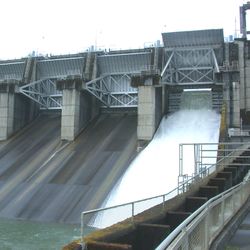Operational measures (turbine operations, spillway passage)
Contents
Introduction
Turbine operations
Without modification of the water intake, the shutdown of conventional turbines is the only solution to avoid turbine passage and the corresponding fish mortality rates. This solution can in principle be effective, but can become very costly for the hydroelectric operator if the shutdowns are not targeted. The challenge is not only to target, but also to anticipate the events of downstream migration.
Water spill
Water spill over dams and gates, partly combined with periodic stop of power plants, have been used to bring down migratory fish past power stations. The method is suitable for periodic fish migrations, such as salmon smolt during spring floods and for eels during autumn and winter floods. These migrations often coincide with flooding where the water flow exceeds the power plant capacity. At run-of-river power plants in North America, this method is frequently used to pass salmon smolts, both for Atlantic salmon and species of Pacific salmon. In Germany it has been used to pass eels (Adam 2000, Egg, etc. 2017). Water spill past turbine intake is considered a safer alternative to turbine passage, but also the use of spill water fish injuries can occur. The loss is still low (2% after Coutant and Whitney 2000). It should be noted that the relationship between water spill and fish migration is not linear, i.e. that increased spill does not necessarily mean a proportional increase in migration past the dam. More important for its efficiency is the placement of the dam relative to main stream and power intake (Coutant and Whitney 2000, Fjeldstad et al. 2011).
Methods, tools, and devices
During planning
Planning of any downstream fish migration systems require a comprehensive study on fish behaviour to assess when and where fish move on their downstream migration. This can be conducted by telemetry experiments or visual observations with video or sonar technology. River hydraulics at the intake must be modelled by 2D or 3D CFD software if needed. The most difficult is to identify the targeted species and their migration period to correctly target the period to stop de turbines.
During implementation
Targeted shut down of turbines need the implementation of devices allowing passage of water by another way than the turbines like gates, valves, etc.
During operation
The device (gate, valve, etc.) needs maintenance.
Relevant MTDs and test cases
Classification table
| Classification | Selection |
|---|---|
| Fish species for the measure | All |
| Does the measure require loss of power production | Operational (requires flow release outside turbine) |
| - | |
| - | |
| Recurrence of maintenance | Irregular at events |
| Which life-stage of fish is measure aimed at | - |
| - | |
| - | |
| Movements of migration of fish | |
| Which physical parameter is addressed | N/A |
| - | |
| - | |
| - | |
| - | |
| - | |
| - | |
| - | |
| Hydropower type the measure is suitable for | Plant in dam |
| Plant with bypass section | |
| Dam height (m) the measure is suitable for | All |
| Section in the regulated system measure is designed for | In dam/power plant |
| - | |
| Bypass section | |
| Downstream outlet | |
| River type implemented | Steep gradient (up to 0.4 %) |
| Fairly steep with rocks, boulders (from 0.4 to 0.05 %) | |
| Slow flowing, lowland, sandy (less than 0.05 %) | |
| Level of certainty in effect | Moderately certain |
| Technology readiness level | TRL 9: actual system proven in operational environment |
| Cost of solution | See cost table |
Relevant literature
- Fjeldstad, H. P., Uglem, I., Diserud, O. H., Fiske, P., Forseth, T., Kvingedal, E., Hvidsten, N. A., Økland, F. and Järnegren, J. A. 2011. A concept for improving smolt migration past hydropower intakes. Journal of Fish Biology 81:642–663.
- Egg, L., Mueller, M., Pander, J., Knott, J. and Geist, J. 2017. Improving European Silver Eel (Anguilla anguilla) downstream migration by undershot sluice gate management at a small-scale hydropower plant, In Ecological Engineering 106, Part A:349-357
- Adam, B. 2000. MIGROMAT: Ein Frühwarnsystem zur Erkennung der Aalabwanderung. [MIGROMAT®: An early warning system to detect eel migration]. Wasser und Boden, 52 (4):16-19.
- Coutant C. C. and Whitney R. R. 2000. Fish behavior in relation to passage through hydropower turbines: a review. Transactions of the American Fisheries Society 129: 351–380
